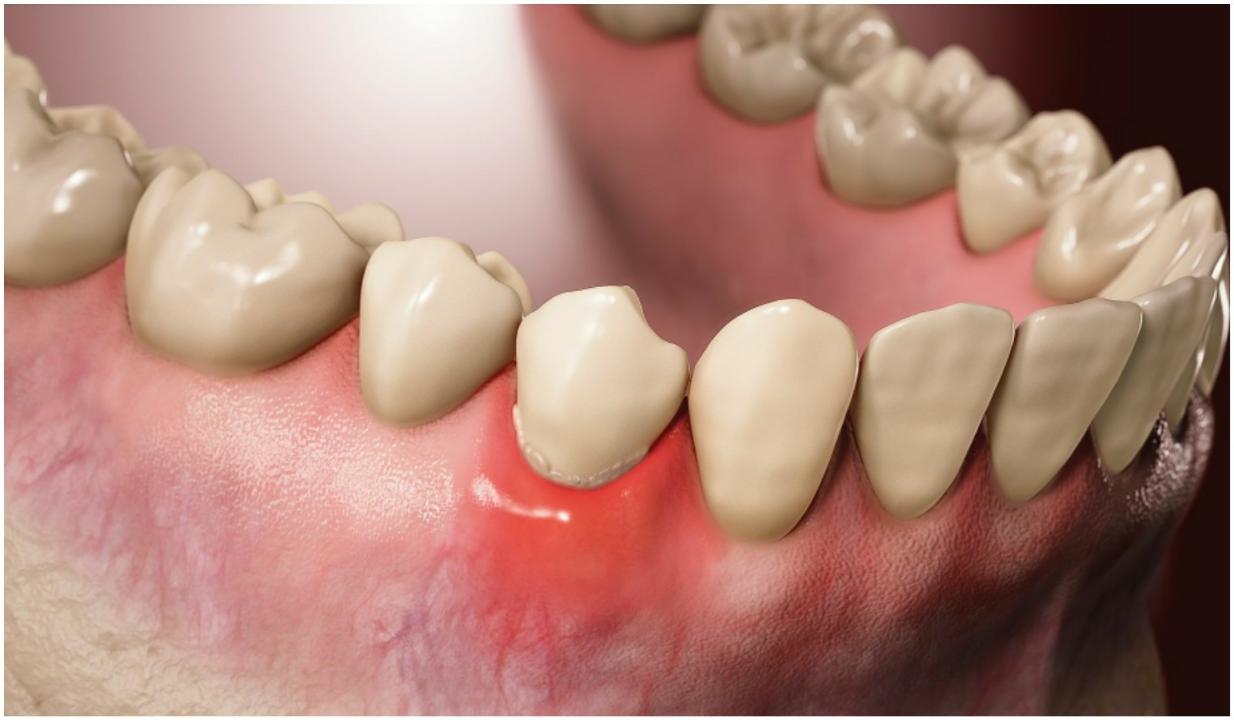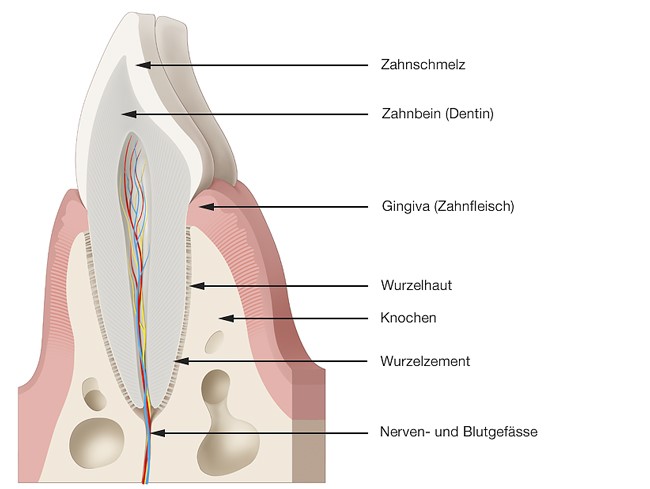Periodontitis therapy
Your specialist in Periodontology
Periodontitis or periodontitis (inflammation of the gums) is an inflammatory change in the periodontium caused by certain types of bacteria. If there is a genetic predisposition, the body reacts to these bacteria with a strong inflammation. In the course of the inflammation, the gums and the bone surrounding the tooth are destroyed. This process continues until treatment is required or the tooth falls out due to the associated loosening.

Similar to the stable foundation of a house, a healthy periodontium forms the basis for all further treatments, regardless of whether implants, crowns or bridges are involved.
In addition to genetic predisposition, there are a number of risk factors that can accelerate the progression of periodontitis and worsen the results of treatment. These primarily include smoking, poor oral hygiene and diabetes.
How does the infection manifest itself?
The disease progresses gradually, almost without pain, and is usually not recognisable by the patient. Bacteria actively attack the gums with enzymes and toxins and can lead to clearly visible inflammation. These inflammations extend deep under the gums to the jawbone – this condition is known as “gingivitis“.
If the bacterial plaque is not removed and tooth supporting fibres and parts of the jawbone are destroyed, this is known as “periodontitis“.
Healthy gums

Inflamed gums – “gingivitis”

Inflamed gums – “periodontitis”

What signs indicate “periodontitis”?
- Bleeding gums when brushing teeth or spontaneous bleeding gums, among other things
- red, swollen or sensitive gums and gums that have receded from the teeth
- Bad breath
- Discharge of secretions or pus from gum pockets
- loose teeth
- Changes in tooth alignment and changes in the fit of partial dentures
Periodontitis treatment
Following these sessions, the actual non-surgical periodontitis treatment is carried out in one (full mouth) or a maximum of two sessions. The only difference to prophylaxis sessions is that this treatment takes place under local anaesthetic so that the root surface can be cleaned deep under the gums. As an innovation, we use a powder specially invented for root planing (Cleanpro), which serves to optimise the smoothing of the root surface.
The overall aim is to remove tartar and bacteria from the root surfaces/gum pockets as thoroughly as possible in order to guarantee the best conditions for optimal healing.
We then give the body two months to regenerate and react to the treatment. After this time, pocket depths are measured again in order to assess the results of the conservative gum treatment. If there are no more pockets, this condition must be maintained for life as part of the prophylaxis follow-up programme.
Lifelong means that the bacteria are largely destroyed, but the genetic conditions cannot be changed. Unfortunately, this means that there is a lifelong risk of developing gingivitis again if the bacteria are given time to multiply and re-establish themselves in the gum pockets.
There is a huge difference in prophylaxis between patients with periodontitis and those who do not suffer from this gum problem.
In our practice Leipziger 14 – Ihre Zahnärzte, dental hygienists ( DH ) specially trained for periodontitis patients check the pocket depths at every prophylaxis session and work closely with our periodontist if necessary. Prophylaxis treatment for a periodontitis patient therefore goes far beyond the scope of conventional tooth cleaning and always represents a kind of minor periodontitis therapy.
In the first year after periodontitis treatment, it is essential to undergo periodontitis prophylaxis approximately every 3 months. If the situation proves to be stable and your oral hygiene is perfect, we will work with you to determine a prophylaxis schedule that is precisely tailored to your needs.
However, if the periodontitis is very advanced and the gum pockets are very deep, conservative (non-surgical) periodontitis treatment reaches its limits. In such cases, the help of specialised dentists (periodontists, gum specialists) is required. As part of the diagnostics and a detailed consultation, all options from surgical periodontitis treatment to minimally invasive extraction and implantation are first examined.
Our periodontist, Dr Yevgeni Viktorov, will first and foremost discuss the wide range of tooth preservation procedures with you to discuss all the pros and cons for long-term tooth preservation. On the other hand, if the long-term prognosis of a tooth is severely compromised periodontally, the dentist will consider other possible treatment options with you.
Surgical periodontitis treatment is essential if there are still deep, inflamed gum pockets after conservative gum treatment has been carried out, or if bone regeneration is an option.
The first aim of surgical periodontitis treatment is to clean the root surface under optimal visibility in order to create an inflammation-free situation. We almost always combine this treatment with bone regeneration (reconstruction).
Surgical gum treatment centres on a gentle surgical approach and careful treatment of the soft tissue. We perform both as part of a minimally invasive, microsurgical concept. We operate with special super-fine instruments at 5x optical magnification. Some of our suture materials originate from vascular surgery.
Only with such delicate, minimally invasive treatment of the gums is it possible to regenerate (build up) bone substance and stabilise it in the long term.
This is because if the gum covering is lost during such an operation due to a non-minimally invasive procedure, the bone and the periodontium cannot regenerate.
As part of surgical periodontitis treatment, the gum and bone pockets are either filled with bone replacement materials and covered with special membranes, or biologically active gels are used to stimulate the patient’s own bone growth.
In recent years, the links between periodontitis and general health have been studied in detail. What we see is that active periodontitis – a chronic inflammation in the body – can have a number of general medical effects on the organism.
For example, the risk of suffering a heart attack or stroke is significantly increased if people suffer from periodontitis.
Other studies clearly show that pregnant women who have periodontal disease have a higher risk of premature births.
Diabetes patients can be much better controlled with medication if they do not suffer from periodontitis.
Have your periodontitis treated, do something good for your teeth AND YOUR BODY!
Smoking is considered an important risk factor for periodontitis. The disease is much more severe in smokers and the results of treatment are unfortunately not as perfect and stable as in non-smokers. Smokers usually have to undergo periodontitis prophylaxis much more frequently to achieve the same result as non-smokers.
If the gums are lost, this can lead to hypersensitive tooth necks, root caries and, of course, aesthetic impairments. In such cases, it is possible to build up gums. Gum reconstruction should be carried out by a periodontist.
Only a very gentle, minimally invasive, microsurgical procedure can lead to long-term success.
As part of gum reconstruction, the gums are prepared so that they can be moved back into their old position, or the gums, which are usually very thin, are replaced with transplanted connective tissue. Just ask our periodontist, Dr Viktorov, he will certainly tell you everything about this subject with great passion.
Patient OPINIONS
Great doctor
Thorough diagnosis; honest recommendation not to carry out the planned special treatment in my case, thus saving me unnecessary treatment costs.
Friendly and competent
I felt safe and in good hands from the very first moment. Dr Planert took the time to answer my questions and explained everything clearly.
Outstanding!
I am completely satisfied! Very courteous reception... Advice and treatment at a very high level. Can recommend Leipziger14-Ihre Zahnärzte and Mr Planert with a clear conscience!"
Great doctor
Thorough diagnosis; honest recommendation not to carry out the planned special treatment in my case, thus saving me unnecessary treatment costs.
Outstanding!
I am completely satisfied! Very courteous reception... Advice and treatment at a very high level. Can recommend Leipziger14-Ihre Zahnärzte and Mr Planert with a clear conscience!"
Friendly and competent
I felt safe and in good hands from the very first moment. Dr Planert took the time to answer my questions and explained everything clearly.

